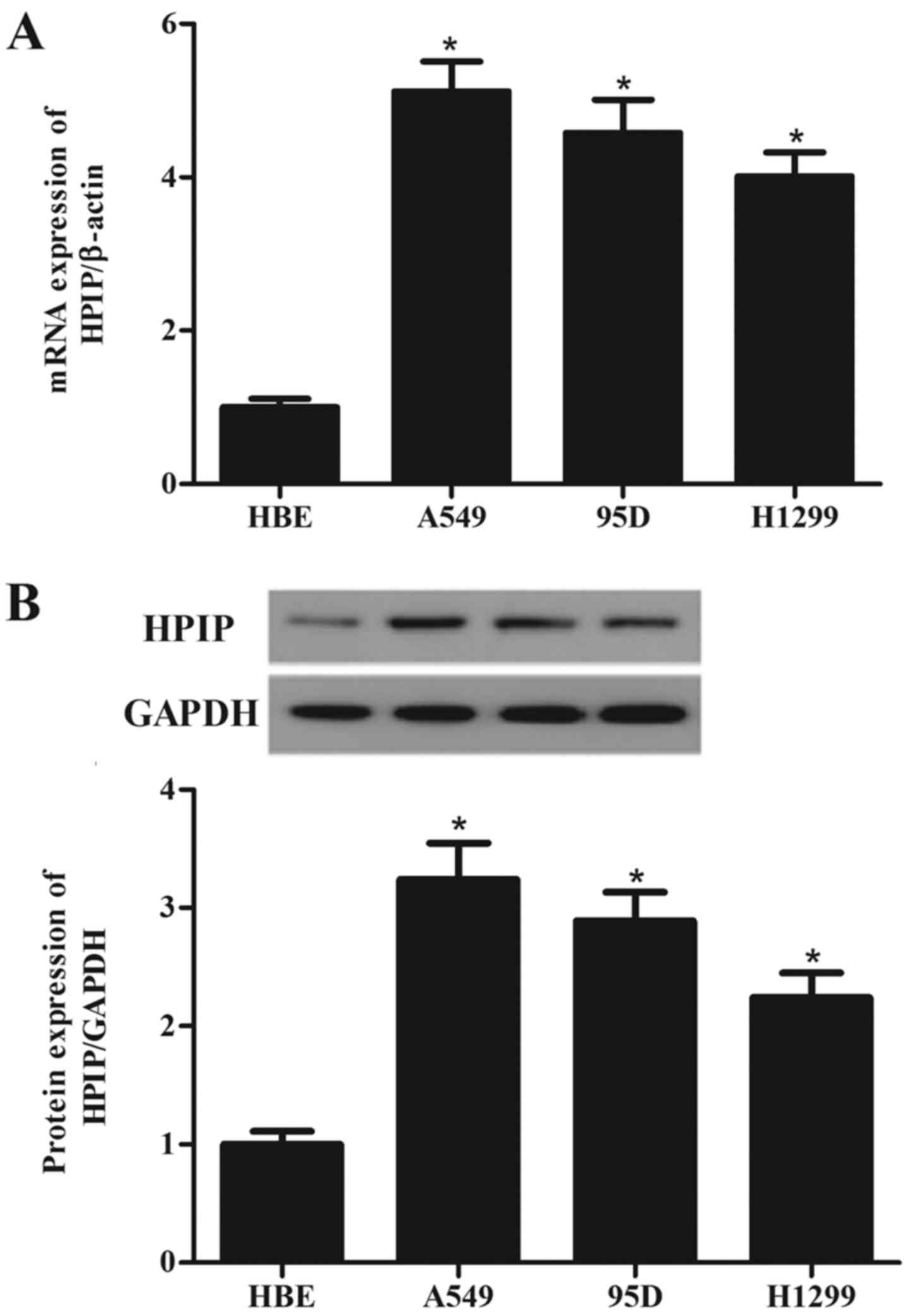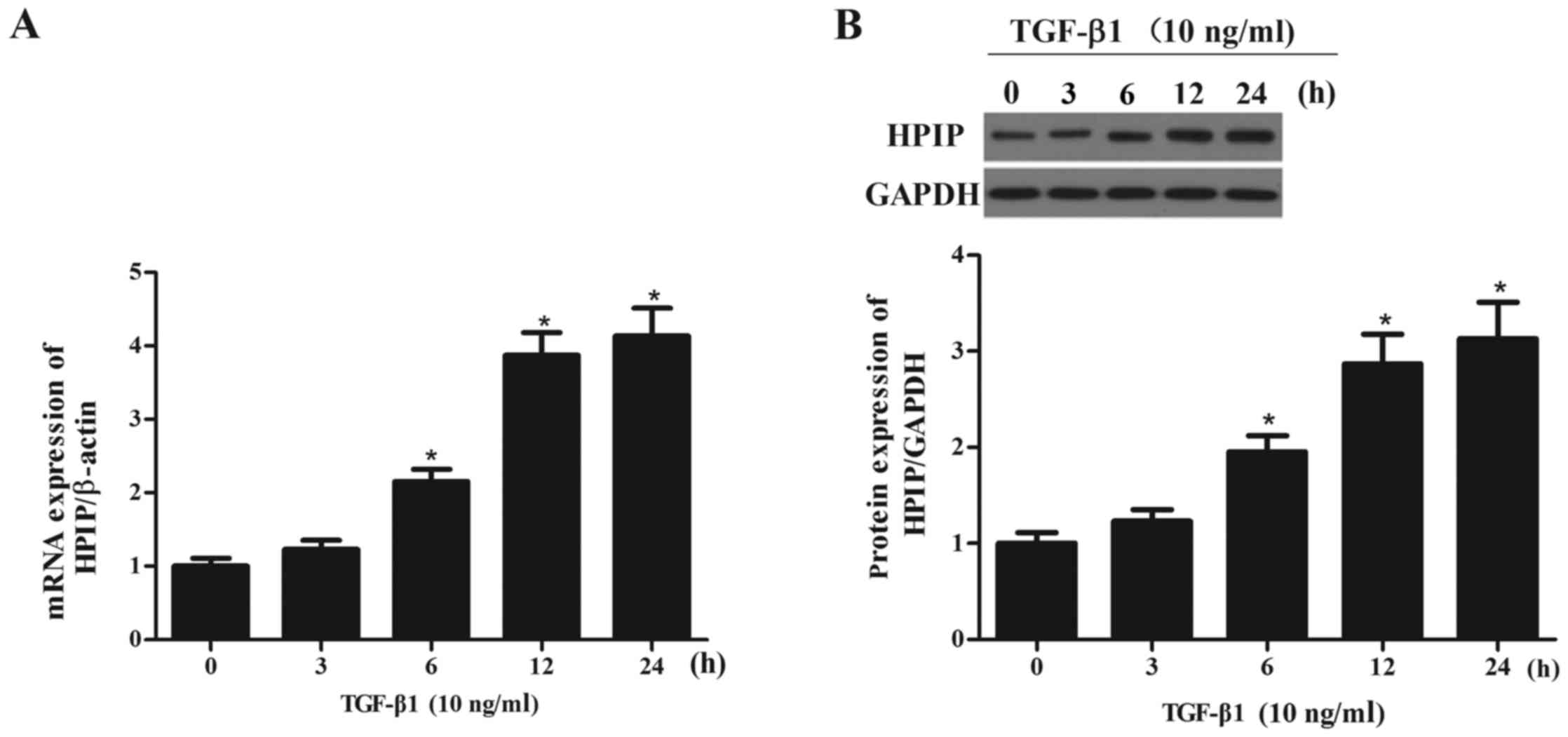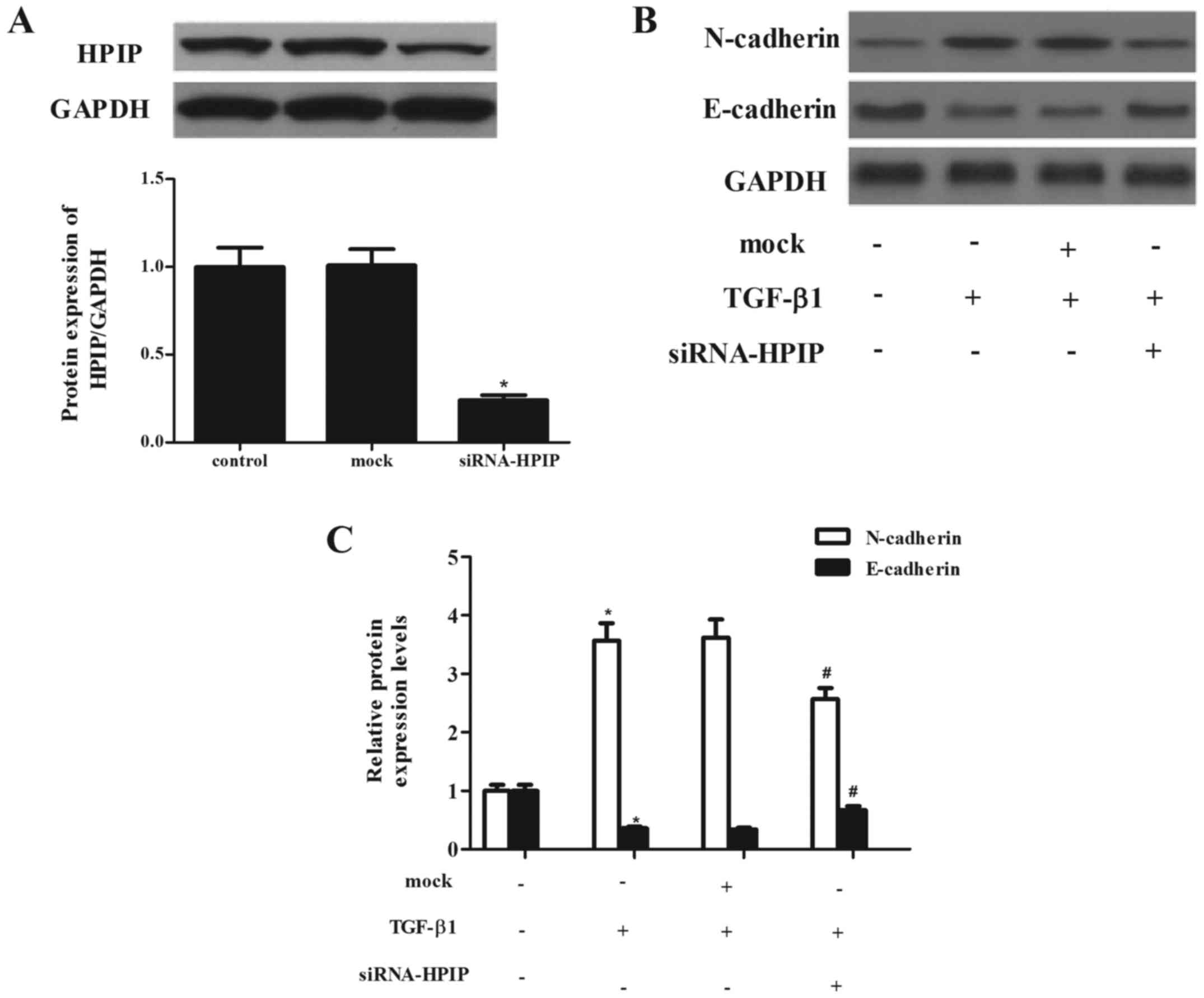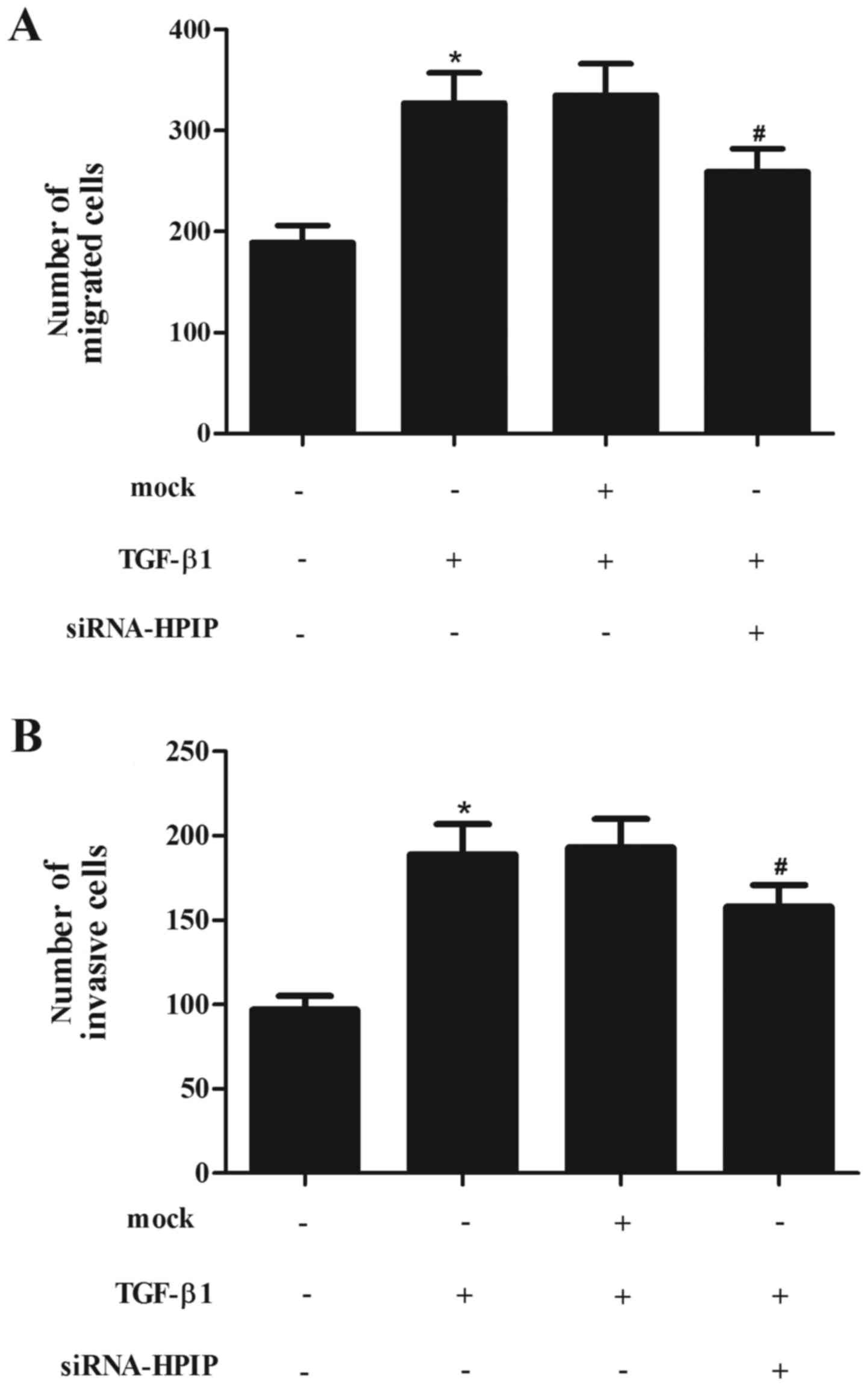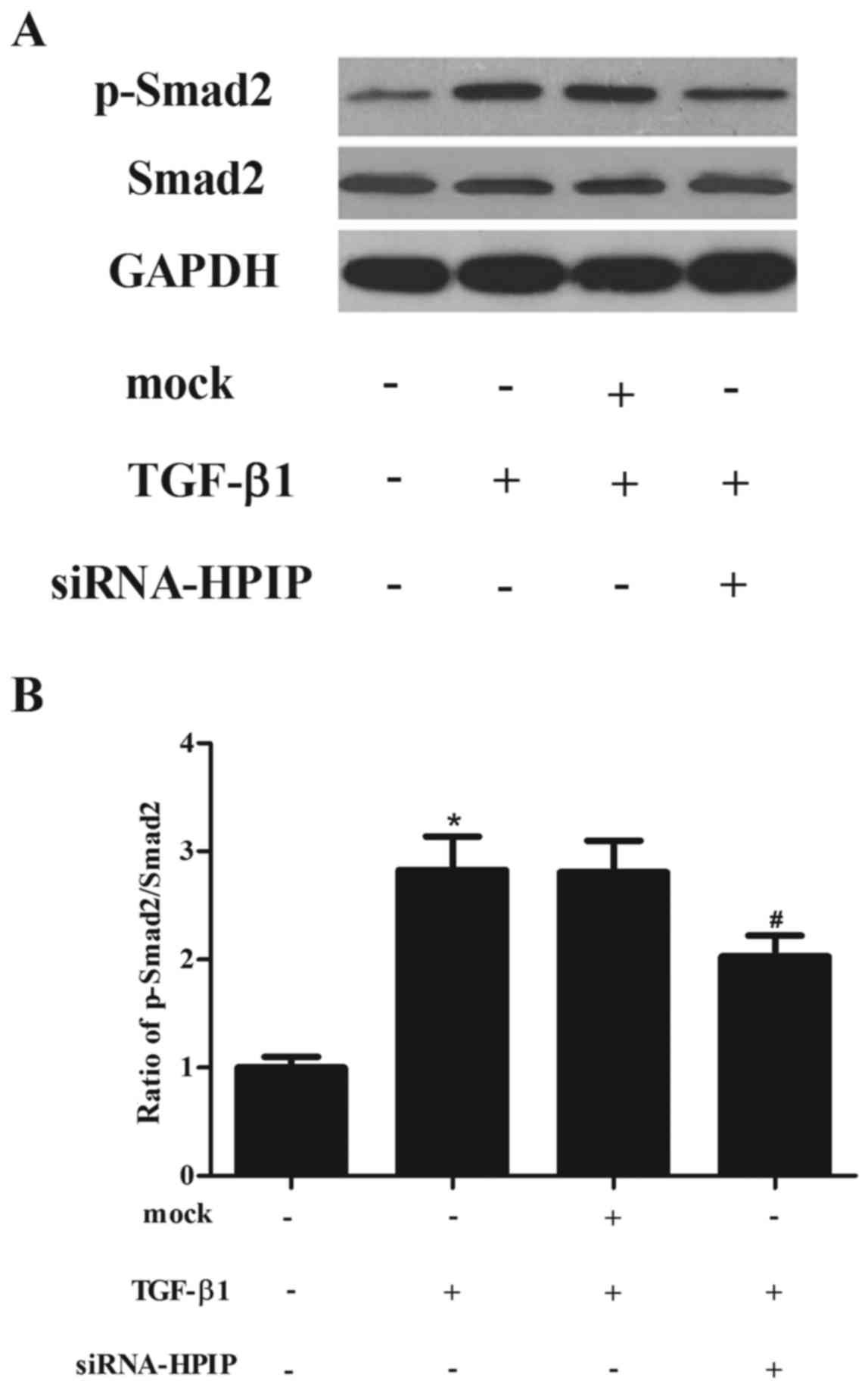HPIP silencing inhibits TGF-β1-induced EMT in lung cancer cells
- Authors:
- Published online on: January 5, 2017 https://doi.org/10.3892/ijmm.2017.2851
- Pages: 479-483
Abstract
Introduction
Lung cancer is one of the most malignant cancers, and the incidence of lung cancer has been rising steadily during the past few decades (1,2). Despite recent advances in the treatment of lung cancer, the molecular mechanisms underlying lung cancer remain unclear and the prognosis for patients with advanced lung cancer remains dismal.
Increasing lines of evidence suggest that epithelial-mesenchymal transition (EMT) plays an important role in cancer progression, invasion and metastasis (3–5). It is defined by the loss of epithelial characteristics and the acquisition of a motile, invasive and migratory mesenchymal phenotype (6). Moreover, transforming growth factor (TGF)-β1 is a multifunctional cytokine and is involved in many biological processes including cell proliferation, differentiation and migration (7). Previous studies have demonstrated that TGF-β1 induces EMT to promote lung adenocarcinoma invasion and metastasis. Therefore, inhibition of TGF-β1 signaling pathway-mediated EMT may yield beneficial therapeutic effects for cancer patients with advanced metastasis.
Hematopoietic pre-B-cell leukemia transcription factor (PBX)-interacting protein (HPIP/PBXIP1), a corepressor of the transcription factor PBX, is involved in organogenesis and tumorigenesis. Feng et al reported that HPIP is upregulated in gastric cancer and induces gastric cancer cell migration and invasion, and modulates EMT (8). HPIP was also found to be overexpressed in astrocytoma and to promote proliferation and migration of astrocytoma cells (9). However, the role of HPIP in lung cancer is unclear. Thus, in the present study, we investigated the role of HPIP in TGF-β1-induced EMT in A549 lung cancer cells in vitro.
Materials and methods
Cell culture and treatment
Lung cancer cell lines (A549, 95D and H1299) and one normal human bronchial epithelial (HBE) cell line were obtained from the American Type Culture Collection (ATCC; Manassas, VA, USA) and cultured in Roswell Park Memorial Institute (RPMI)-1640 medium supplemented with 10% heat-inactivated fetal bovine serum (FBS) under a humidified incubator that was maintained at 37°C and supplied with 5% CO2 and 95% air. Then, A549 cells were treated with TGF-β1 (10 ng/ml) for different periods of time.
RNA preparation and reverse transcription quantitative PCR (RT-qPCR)
Total RNA was extracted from cells with TRIzol reagent (Invitrogen, Carlsbad, CA, USA) following the manufacturer's instructions, and 1 µg of each was used for reverse transcription using the iScript cDNA Synthesis kit (Bio-Rad Laboratories, Inc., Hercules, CA, USA). The primer sequences used are as follows: HPIP forward, 5′-GTCCCCTCGAGGAGTTGTGT-3′ and reverse, 5′-ATCTTCCATCATCTGAGGGC-3′; β-actin forward, 5′-CATGTACGTTGCTATCCAGGC-3′ and reverse, 5′-CTCCTTAATGTCACGCACGAT-3′. The steps for PCR were performed as follows: 35 cycles of denaturation at 94°C for 30 sec, annealing at 54°C for 30 sec, and polymerization at 72°C for 30 sec. β-actin was used as a control for normalizing gene expression. The data obtained were calculated by the 2−ΔΔCt method.
Western blotting
Cells were homogenized and lysed with RIPA lysis buffer (100 mM NaCl, 50 mM Tris-HCl pH 7.5, 1% Triton X-100, 1 mM EDTA, 10 mM β-glycerophosphate, 2 mM sodium vanadate and protease inhibitor). The protein concentration was measured using a BCA protein assay kit. Equal amount of protein was separated by sodium dodecyl sulfate-polyacrylamide gel electrophoresis (SDS-PAGE) and then transferred to a polyvinylidene fluoride (PVDF) membrane. The membrane was blocked with 5% non-fat milk solution for 1 h, and then was incubated with a primary mouse monoclonal antibody against HPIP (1:3,000; H00057326-M02; Abnova, Walnut, CA, USA), E-cadherin (1:1,500; sc-71008), N-cadherin (1:2,000; sc-53488) (both from Santa Cruz Biotechnology, Inc., Santa Cruz, CA, USA), and rabbit monoclonal antibody against Smad2 (1:2,000; sc-101153) or p-Smad2 (1:2,000; sc-101801) (both from Santa Cruz Biotechnology, Inc.) at 4°C overnight. GAPDH (1:1,500; sc-166574; Santa Cruz Biotechnology, Inc.) was used as the loading control. Following three washes with TBST buffer, HRP-conjugated secondary antibodies [rabbit anti-mouse HRP-conjugated secondary antibody (1:3,000; sc-358923) or goat anti-rabbit horseradish peroxidase conjugated secondary antibody (1:3,000; sc-2054); both from Santa Cruz Biotechnology, Inc.] were introduced, and enhanced chemiluminescence (ECL; Amersham Pharmacia, Piscataway, NJ, USA) was used for detection.
Transfection of siRNA against HPIP
siRNA was transfected into cells using Lipofectamine 2000 transfection reagent (Life Technologies) by following the manufacturer's instructions. siRNA against HPIP was synthesized by Shanghai GenePharma Co., Ltd. (Shanghai, China). siRNA knockdown efficiency was verified by western blotting of HPIP expression.
Cell migration assay
Cell migration was determined using a modified Boyden chamber model (Transwell apparatus, 8.0-µm pore size; Costar, Cambridge, MA, USA). Briefly, A549 cells (1×105 cells/well) transfected with siRNA-HPIP or mock were seeded onto the upper chamber containing serum free culture medium. In addition, 500 µl of medium supplemented with 10% FBS was added to the lower compartment. After incubation for 24 h, all non-migrant cells were removed from the upper faces of the Transwell membranes with a cotton swab and the migrated cells were fixed and stained with 0.1% crystal violet. Migration was quantified by counting the number of stained cells per 100 x field (high power field) in images captured with a microscope.
Cell invasion assay
The invasiveness of RPE cells was examined using a Matrigel-coated modified Boyden chamber. Briefly, the A549 cells (1×105 cells/well) transfected with siRNA-HPIP or mock were seeded onto the upper chamber containing serum-free culture medium. The lower compartment of the chamber was filled with culture medium containing 10% FBS, and a nitrocellulose filter was placed in it. After incubation for 24 h, the cells on the upper surface were removed, and cells on the lower filters were fixed with 95% methanol and stained with 0.1% crystal violet. Then the number of migrated cells was counted under a microscope.
Statistical analysis
All data are expressed as mean ± SD. One-way analysis of variance (ANOVA) was used for multiple sample analysis. P<0.05 was considered to be statistically significant.
Results
HPIP is highly expressed in lung cancer cell lines
To investigate the role of HPIP in the tumorigenesis of lung cancer, we detected the HPIP expression in three lung cancer cell lines and normal HBE cells. Compared with the HBE cells, HPIP expression was higher in the A549, 95D and H1299 cells than the expression noted in the HBE cells (Fig. 1A). Western blotting showed similar results (Fig. 1B).
TGF-β1 increases the expression of HPIP in lung cancer cells
To determine whether the observed changes in HPIP expression were associated with TGF-β1-mediated EMT, we investigated the effect of TGF-β1 on the expression levels of HPIP in the A549 cells. As shown in Fig. 2, TGF-β1 treatment significantly increased the expression of HPIP at both the mRNA and protein levels in the A549 cells, in a time-dependent manner.
HPIP silencing significantly attenuates TGF-β1-induced EMT in lung cancer cells
To evaluate the effect of HPIP on lung cancer carcinogenesis, we detected the EMT phenotype after HPIP was downregulated. Through RNAi, a stable HPIP-knockdown clone in A549 cells and negative control (mock) clone were generated. As shown in Fig. 3A, siRNA-HPIP significantly decreased HPIP expression in the A549 cells, as compared with the level in the mock group.
TGF-β1 has been reported to induce EMT in A549 lung cancer cells (10). Thus, we investigated the effect of HPIP on TGF-β1-induced EMT in A549 cells. As previously reported, treatment with TGF-β1 markedly induced the expression of N-cadherin and inhibited the expression of E-cadherin. However, knockdown of HPIP significantly suppressed TGF-β1-mediated upregulation of N-cadherin and suppression of E-cadherin in the A549 cells (Fig. 3B and C).
HPIP silencing significantly attenuates TGF-β1-induced migration and invasion in lung cancer cells
EMT has been indicated as a key step in the initiation of cancer cell migration. Thus, we evaluated the effect of HPIP on TGF-β1-induced migration and invasion in A549 cells. As shown in Fig. 4A, treatment with TGF-β1 obviously promoted A549 cell migration. However, knockdown of HPIP significantly inhibited TGF-β1-induced migration. Consistent with the results of the Transwell assay, knockdown of HPIP greatly inhibited A549 cell invasion induced by TGF-β1 (Fig. 4B).
HPIP silencing inhibits the TGF-β1/Smad2 signaling pathway in A549 cells
TGF-β1-induced EMT is mediated through Smad signaling pathways. Therefore, we examined whether HPIP silencing suppresses TGF-β1-induced phosphorylation of Smad2. As shown in Fig. 5, western blotting showed that TGF-β1 treatment promoted the phosphorylation of Smad2, which was significantly decreased by siRNA-HPIP in the A549 cells.
Discussion
In the present study, we showed for the first time a role of HPIP as an oncogene in lung cancer. First, HPIP was overexpressed in the lung cancer cell lines. Second, TGF-β1 increased the expression of HPIP in the lung cancer cells. Third, HPIP silencing significantly attenuated TGF-β1-induced EMT and migration/invasion in the lung cancer cells. Finally, knockdown of HPIP greatly inhibited the TGF-β1-promoted phosphorylation of Smad2 in the A549 cells.
The expression level of HPIP has been found to be significantly associated with tumor progression and metastasis in several malignant tumors including liver, breast and colorectal cancer (11–13). Recently, Wang et al demonstrated that the expression of HPIP is upregulated in thyroid carcinoma cell lines (14). Consistently, in this study, we observed that HPIP was highly expressed in the lung cancer cell lines. Furthermore, TGF-β1 is a multifunctional cytokine that regulates a wide range of cellular functions. It was reported that blood levels of TGF-β1 are elevated in patients with lung cancer when compared with normal patients (15), and increased production of TGF-β by cancer cells during tumor progression can promote tumor growth, angiogenesis, and metastasis (16). In the present study, we observed that TGF-β1 treatment significantly increased the expression of HPIP in lung cancer cells. Accordingly, these results clearly suggest that HPIP functions as an oncogene in lung cancer.
It has been reported that EMT contributes to increased metastatic progression in the development of cancer (3,17,18). Increasing evidence suggests that loss of E-cadherin function or high expression of vimentin are common in lung cancer and are correlated with poor patient prognosis (19,20). Moreover, in vitro evidence clearly demonstrates that TGF-β1 stimulates EMT in lung cancer cells (21). In the present study, we found that knockdown of HPIP significantly suppressed TGF-β1-mediated upregulation of N-cadherin and suppression of E-cadherin in A549 cells. We also found that HPIP silencing significantly attenuated TGF-β1-induced migration and invasion in the A549 cells. These results suggest that knockdown of HPIP inhibits TGF-β1-induced EMT in A549 cells, thus inhibiting lung cancer cell migration and invasion.
Altered TGF-β signaling has been implicated in tumor development and progression. It is known that TGF-β1 transmits intracellular signals via the Smad pathway (22). After TGF-β1 stimulation, Smad2 and Smad3 are phosphorylated, and then phosphorylated Smad2 and Smad3 form heteromeric complexes with a mediator Smad4. These Smad2/3/4 complexes translocate to the nucleus, where they control specific target genes by binding with transcription factors, and subsequently induce development of EMT in cancer cells (23). Smad3 is considered to be the primary signaling molecule in mediating EMT in many types of tumors (24,25). However, EMT in several types of cancer cells has been shown to depend on Smad2 signaling (26,27). In addition, several investigators have shown that the A549 lung cancer cell line undergoes EMT upon TGF-β1 treatment (7,28,29). In the present study, we examined the effect of HPIP on the expression of Smad2 in TGF-β1-induced A549 cells and found that HPIP silencing inhibited activation of Smad2 in TGF-β1-induced EMT. These results suggest that HPIP silencing inhibits TGF-β1-induced EMT in lung cancer cells by inhibiting Smad2 activation.
In conclusion, we demonstrated that HPIP silencing suppressed TGF-β1-induced EMT in lung cancer cells by inhibiting Smad2 activation. Therefore, HPIP may be a new therapeutic target for the treatment of lung cancer.
References
|
Greenlee RT, Murray T, Bolden S and Wingo PA: Cancer statistics, 2000. CA Cancer J Clin. 50:7–33. 2000. View Article : Google Scholar : PubMed/NCBI | |
|
Wakelee HA, Chang ET, Gomez SL, Keegan TH, Feskanich D, Clarke CA, Holmberg L, Yong LC, Kolonel LN, Gould MK, et al: Lung cancer incidence in never smokers. J Clin Oncol. 25:472–478. 2007. View Article : Google Scholar : PubMed/NCBI | |
|
Huber MA, Kraut N and Beug H: Molecular requirements for epithelial-mesenchymal transition during tumor progression. Curr Opin Cell Biol. 17:548–558. 2005. View Article : Google Scholar : PubMed/NCBI | |
|
Yang J and Weinberg RA: Epithelial-mesenchymal transition: at the crossroads of development and tumor metastasis. Dev Cell. 14:818–829. 2008. View Article : Google Scholar : PubMed/NCBI | |
|
Thompson EW, Newgreen DF and Tarin D: Carcinoma invasion and metastasis: a role for epithelial-mesenchymal transition? Cancer Res. 65:5991–5995; discussion 5995. 2005. View Article : Google Scholar : PubMed/NCBI | |
|
Iwatsuki M, Mimori K, Yokobori T, Ishi H, Beppu T, Nakamori S, Baba H and Mori M: Epithelial-mesenchymal transition in cancer development and its clinical significance. Cancer Sci. 101:293–299. 2010. View Article : Google Scholar | |
|
Bierie B and Moses HL: TGF-beta and cancer. Cytokine Growth Factor Rev. 17:29–40. 2006. View Article : Google Scholar | |
|
Feng Y, Li L, Zhang X, Zhang Y, Liang Y, Lv J, Fan Z, Guo J, Hong T, Ji B, et al: HPIP is overexpressed in gastric cancer and promotes gastric cancer cell proliferation, migration and invasion. Cancer Sci. 106:1313–1322. 2015. View Article : Google Scholar : PubMed/NCBI | |
|
van Vuurden DG, Aronica E, Hulleman E, Wedekind LE, Biesmans D, Malekzadeh A, Bugiani M, Geerts D, Noske DP, Vandertop WP, et al: Pre-B-cell leukemia homeobox interacting protein 1 is overexpressed in astrocytoma and promotes tumor cell growth and migration. Neuro Oncol. 16:946–959. 2014. View Article : Google Scholar : PubMed/NCBI | |
|
Kim AN, Jeon WK, Lim KH, Lee HY, Kim WJ and Kim BC: Fyn mediates transforming growth factor-beta1-induced down-regulation of E-cadherin in human A549 lung cancer cells. Biochem Biophys Res Commun. 407:181–184. 2011. View Article : Google Scholar : PubMed/NCBI | |
|
Xu X, Jiang C, Wang S, Tai Y, Wang T, Kang L, Fan Z, Li S, Li L, Fu J, et al: HPIP is upregulated in liver cancer and promotes hepatoma cell proliferation via activation of G2/M transition. IUBMB Life. 65:873–882. 2013.PubMed/NCBI | |
|
Bugide S, David D, Nair A, Kannan N, Samanthapudi VS, Prabhakar J and Manavathi B: Hematopoietic PBX-interacting protein (HPIP) is over expressed in breast infiltrative ductal carcinoma and regulates cell adhesion and migration through modulation of focal adhesion dynamics. Oncogene. 34:4601–4612. 2015. View Article : Google Scholar | |
|
Feng Y, Xu X, Zhang Y, Ding J, Wang Y, Zhang X, Wu Z, Kang L, Liang Y, Zhou L, et al: HPIP is upregulated in colorectal cancer and regulates colorectal cancer cell proliferation, apoptosis and invasion. Sci Rep. 5:9429–9439. 2015. View Article : Google Scholar : PubMed/NCBI | |
|
Wang SC, Chai DS, Chen CB, Wang ZY and Wang L: HPIP promotes thyroid cancer cell growth, migration and EMT through activating PI3K/AKT signaling pathway. Biomed Pharmacother. 75:33–39. 2015. View Article : Google Scholar : PubMed/NCBI | |
|
Kong FM, Washington MK, Jirtle RL and Anscher MS: Plasma transforming growth factor-beta 1 reflects disease status in patients with lung cancer after radiotherapy: a possible tumor marker. Lung Cancer. 16:47–59. 1996. View Article : Google Scholar : PubMed/NCBI | |
|
Akhurst RJ and Derynck R: TGF-beta signaling in cancer - a double-edged sword. Trends Cell Biol. 11:S44–S51. 2001.PubMed/NCBI | |
|
Thiery JP: Epithelial-mesenchymal transitions in tumour progression. Nat Rev Cancer. 2:442–454. 2002. View Article : Google Scholar : PubMed/NCBI | |
|
Moustakas A and Heldin CH: Signaling networks guiding epithelial-mesenchymal transitions during embryogenesis and cancer progression. Cancer Sci. 98:1512–1520. 2007. View Article : Google Scholar : PubMed/NCBI | |
|
Sato M, Shames DS and Hasegawa Y: Emerging evidence of epithelial-to-mesenchymal transition in lung carcinogenesis. Respirology. 17:1048–1059. 2012. View Article : Google Scholar : PubMed/NCBI | |
|
Nakata S, Sugio K, Uramoto H, Oyama T, Hanagiri T, Morita M and Yasumoto K: The methylation status and protein expression of CDH1, p16(INK4A), and fragile histidine triad in nonsmall cell lung carcinoma: epigenetic silencing, clinical features, and prognostic significance. Cancer. 106:2190–2199. 2006. View Article : Google Scholar : PubMed/NCBI | |
|
Zavadil J and Böttinger EP: TGF-beta and epithelial-to-mesenchymal transitions. Oncogene. 24:5764–5774. 2005. View Article : Google Scholar : PubMed/NCBI | |
|
Heldin CH, Miyazono K and ten Dijke P: TGF-beta signalling from cell membrane to nucleus through SMAD proteins. Nature. 390:465–471. 1997. View Article : Google Scholar : PubMed/NCBI | |
|
Dumont N and Arteaga CL: Transforming growth factor-beta and breast cancer: tumor promoting effects of transforming growth factor-beta. Breast Cancer Res. 2:125–132. 2000. View Article : Google Scholar | |
|
Risolino M, Mandia N, Iavarone F, Dardaei L, Longobardi E, Fernandez S, Talotta F, Bianchi F, Pisati F, Spaggiari L, et al: Transcription factor PREP1 induces EMT and metastasis by controlling the TGF-β-SMAD3 pathway in non-small cell lung adenocarcinoma. Proc Natl Acad Sci USA. 111:E3775–E3784. 2014. View Article : Google Scholar | |
|
Yamazaki K, Masugi Y, Effendi K, Tsujikawa H, Hiraoka N, Kitago M, Shinoda M, Itano O, Tanabe M, Kitagawa Y, et al: Upregulated SMAD3 promotes epithelial-mesenchymal transition and predicts poor prognosis in pancreatic ductal adenocarcinoma. Lab Invest. 94:683–691. 2014. View Article : Google Scholar : PubMed/NCBI | |
|
Oft M, Akhurst RJ and Balmain A: Metastasis is driven by sequential elevation of H-ras and Smad2 levels. Nat Cell Biol. 4:487–494. 2002. View Article : Google Scholar : PubMed/NCBI | |
|
Lv ZD, Kong B, Li J-G, Qu HL, Wang XG, Cao WH, Liu XY, Wang Y, Yang ZC, Xu HM, et al: Transforming growth factor-β 1 enhances the invasiveness of breast cancer cells by inducing a Smad2-dependent epithelial-to-mesenchymal transition. Oncol Rep. 29:219–225. 2013. | |
|
Kasai H, Allen JT, Mason RM, Kamimura T and Zhang Z: TGF-beta1 induces human alveolar epithelial to mesenchymal cell transition (EMT). Respir Res. 6:56–70. 2005. View Article : Google Scholar : PubMed/NCBI | |
|
Willis BC and Borok Z: TGF-beta-induced EMT: mechanisms and implications for fibrotic lung disease. Am J Physiol Lung Cell Mol Physiol. 293:L525–L534. 2007. View Article : Google Scholar : PubMed/NCBI |



